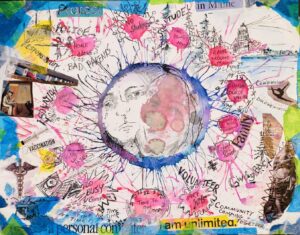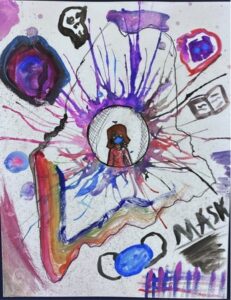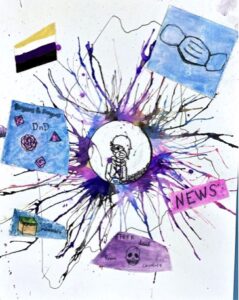The Jack Pine Project: Art, Catharsis and Recovery
Kreg Ettenger, Ph.D.
Director, Maine Folklife Center and Maine Studies Program
University of Maine
[This essay was published in From Home in Bunny Slippers: Creations from a Community in the Weirdest Year Ever, published by the Chocolate Church, Bath, Maine. To learn more and to purchase the book, click HERE.]
When the coronavirus hit earlier this year, I was among those in academia who had to swiftly transition to working at home and teaching via “distance learning” technologies. But this was not a difficult transition for me. I had been using these technologies for well over a decade. And working at home was not a problem, as I had the tools and the space to do so, and no children or other serious obligations on my time.
But others were not so lucky. I could see right away that many people were struggling with their new circumstances. Some had to suddenly become home-school teachers, while also fulfilling work and family obligations and meeting other demands. Some worked in jobs that required them to face the very real dangers of the growing pandemic, risking their very lives, and those of their families, to provide for themselves and help others survive. Some lost their jobs in the rapid economic shutdown that followed. And some lost their lives, or loved ones, to COVID-19.
As I sat and watched these changes affecting our society, I wondered if there was anything I could do to help. I also wondered if there was a way to use this global pandemic to create something that would help people make sense of this experience. I had been inspired in the past by stories of how art transformed lives, such as prisoners telling their stories through creative writing and veterans expressing their feelings through music, usually with the help of inspiring teachers and mentors.
As director of the Maine Studies Program and Maine Folklife Center at the University of Maine, I am aware of the importance of art in society. I understand, for example, the way folk music often told the stories of tragic events, like war and disaster, carrying memories of these events well into the future. I also knew that artists were among those who helped shape popular views of our world. I even started a lecture series, “Framing Maine: Conversations with Storytellers and Image Makers from the Pine Tree State,” that invited writers, musicians, artists and others to the UMaine campus to talk about how they told our state’s many stories through their art.
As I considered the tragedy that was unfolding due to COVID-19, I thought about how to use art to both memorialize and respond to this cultural event. An image came to mind of a tree seedling growing up out of scorched earth, bringing new life to a devastated landscape. I have always been intrigued by the Jack Pine, Pinus banksiana, a tree species native to Canada and the northernmost parts of the U.S., including Maine. This species has such tight cones that it needs one of two things—extreme heat, or extreme cold—to open them and disperse its seeds. A wildfire does just that.
The COVID-19 pandemic is like a wildfire of disease, death, fear, and economic collapse. We have seen its effects all around us, from the nearly 200,000 dead and counting in the US alone, to the many who have survived but are still recovering, to families, businesses and communities devastated by its impacts. It swept through our country, and our state, like the wildfires that are now ravaging the west, leaving destruction in its path. Even as we begin to recover, there are new waves of devastation, new outbreaks related to things like weddings and parties and family reunions—normally the happiest occasions in our lives. Its effects will last for years.
And these effects are not even. The greatest impacts have been upon our most vulnerable populations: the elderly, those with chronic illnesses, the poor, recent immigrants, those who are incarcerated or otherwise confined in institutions. Also deeply affected are those who have put themselves directly in harm’s way, either out of economic necessity or because they wish to help. There is a special cruelty to a tragedy that targets those among us least able to protect themselves, or most willing to risk their own lives for others.
About the Jack Pine Project
The Jack Pine Project is a community-based art project designed to do three main things: 1) document the coronavirus pandemic through the arts; 2) allow the people who have been most affected to tell their stories and express their feelings, with or without words; and 3) help artists affected by the pandemic by paying them to teach others to make art. Funding comes from the Maine Folklife Center through gifts made in support of its mission, which is to document and preserve Maine’s cultural heritage, including folk arts. The Jack Pine Project is in many ways a folk art project, designed to help amateur artists create a regional cultural memory of the coronavirus pandemic through various forms of creative art.
While the Maine Folklife Center initiated the project, it was developed with support from the University of Maine’s Hutchinson Center in Belfast. The center provided both creative and logistical support ranging from developing and marketing the workshops to working with instructors, such as helping to arrange Zoom meetings and making sure they were comfortable with the technology. Several workshops were also based in the Belfast area, drawing upon connections the Hutchinson Center has with local organizations such as the Belfast Creative Coalition and Our Town Belfast.
The Jack Pine Project involves individual workshops lasting from two weeks to several months, usually using Zoom to connect with students and help them create their art. The workshops include the visual arts (printmaking, weaving, drawing, mixed media), music (songwriting, group performance), drama (monologues, playwriting), and writing (short stories and memoirs). If the project continues, we hope to broaden this even further to forms like filmmaking and dramatic and musical performance.
One approach taken initially was to focus on “cohorts” of people representing various affected populations around the state. We developed a list of groups whose perspectives we thought were important to document, such as first responders, health care workers, workers and residents of eldercare facilities, those with chronic illnesses, New Mainers and other ethnic or racial minorities, and several others. In the end, though, it was difficult to make connections with these groups and find cohorts that were small enough to work with but large enough to be representative. We ended up allowing artists to create their own cohorts if they could, often with guidance from us, or we marketed workshops to the public with suggestions about whom they might appeal to. Our initial set of workshops therefore included “open” workshops that anyone could register for, and “restricted” workshops whose cohorts were limited to a particular group, often arranged by the instructor.
Open workshops included the following:
- “Sharing Our Stories Through Weaving” with Celia Shaheen
- “Process Drawing for Families” with Becky Jane Rosen
- “Printmaking in Place: Pandemic Edition” with Susan Smith
- “Beauty in the Mundane: Creating Audio Portraits” with Eleanor Kipping
- “Processing Pain Through Prints” with Jodi Ferry
- “Singing Our Stories” with Kate Beever
Closed or restricted workshops included:
- “Songwriting for Self-Expression” with Carla Tanguay (for cancer patients)
- “Pandemic Reflections” with Sarah Sherman (for incarcerated veterans)
- “Coronavirus Mind Mapping” with Jessica Hamilton-Jones (for youth in Waterville)
- “Scenes from a Darkened Stage” with Stephen Legawiec (for the theatre arts sector)
- “The View from Main Street” with Judy Zocchi (for small business owners in Belfast)
Instructors were given considerable latitude to develop their workshops the way they saw fit in terms of the medium, level of instruction, and their own visions for the art created. We did, however, impress upon the artists a few key goals of the project. One was that the art created had to be about the coronavirus in some way, and not just be representations of scenic landscapes or other Maine themes. Similarly, the workshops had to be more than simply instructional, such as teaching a particular method of making art. Instruction was certainly a part of the project, but was seen as a means to an end. And finally, we did not simply provide grants to artists to produce their own work. Each workshop had to be about teaching others, especially novices, how to create a particular type of art, and then use this new skill to represent their feelings and impressions about the coronavirus pandemic.
Results from Two Workshops
Below are some preliminary results from two workshops, one involving songwriting with cancer patients in the Ellsworth area, and the other involving mixed media “mind maps” based on the image of the coronavirus made by at-risk youth and with adults with special needs in the Waterville area.
Covid and Cancer Songwriting Workshop
By Carla Tanguay
When I thought about cohorts who would have a specific and unique experience of life during COVID-19, I immediately thought of people already facing serious illness. The Beth Wright Cancer Center in Ellsworth is a local resource center very active in promoting creative programming, which had transitioned many offerings to Zoom. I had partnered with them previously, and reached out to see if they would help recruit participants for a songwriting workshop. They identified several community members who they thought would like to participate.
Composing a song when you don’t consider yourself a musician can be a formidable task. But for these participants, who were already facing a cancer diagnosis and adapting to life during COVID-19, it was a challenge they were excited to take on. Songs, experiences, and connections were created, shared, and documented over several weeks of Zoom meetings. Our group was small, which allowed for a level of intimacy that is normally challenging over Zoom. The participants didn’t know each other previously and were in different stages of their cancer journey, but bonds very quickly developed between members. Connecting over music is part of human nature, and we have been doing it for generations.
We began our workshop by sharing our favorite musical styles and songs. We spoke about how music helps connect us to our history, to our hopes, and to each other. We also spoke about how COVID-19 has impacted our lives so far, and how the balance between our physical and mental health has become critical during this time of social distancing. We explored what it is like to live through a pandemic while also having a cancer diagnosis, and what lessons from cancer have carried over and helped them cope during COVID-19.
It didn’t take long for the group to begin writing their own songs. We quickly progressed from a humorous Mad Libs songwriting exercise to fill-in-the-blank compositions using existing songs. New lyrics were created to tunes like “Leaving on a Jet Plane,” “On Top of Old Smokey,” and “I Can See Clearly Now.” Songs touched on everything from grocery shopping during the pandemic, to racism and social injustices, to imagining a time when cancer and COVID-19 have both been defeated.
Initially, each participant worked independently, and emails of new song lyrics were passed around over the weeks. Although each participant claimed not to be a singer, each sang their new versions of these songs to us on Zoom in the coming weeks and received much support from the others. The spark was lit and the creative process took off.
Our final project was an original song based on John Lennon’s “Happy Xmas (War is Over),” whose melody is itself based on a much older folk song. This song was an opportunity to collaborate together on lyrics, melody, and recording. We formulated the concept and then worked diligently on revising the lyrics to include the variety of perspectives represented in our group. We wanted to capture the layers of uncertainty and fear that underlie both a cancer diagnosis and the COVID-19 pandemic.
Once lyrics were finished, individual members took upon the challenging technological task of recording themselves singing along to a guide track. As the instructor, I took it upon myself to stitch the pieces together using music editing software to create a blended piece. The hope was to create a unified recording that represents participants’ feelings about COVID-19 and cancer, and also captures how we, as songwriters, could be physically apart but still create something amazing together. The lyrics below help describe the experience of COVID-19 through the eyes of Maine cancer patients. The recorded song will eventually be available on the project website, jackpineproject.com.
So This is Covid
[based on “Happy Xmas” by John Lennon]
3/4 time
Rhyme Scheme: ABCB
So this is COVID
A deadly disease
Silent and stealthy
Until we can’t breathe
A life-threatening illness
We call COVID-19
We’ve lost far too many
And most go unseen.
And so this is Cancer
How much can we take?
The pain and the suffering
With hardly a break
A stressful 2020
Not such a good year
We must keep our distance
But I want someone here
[Chorus]
Covid and Cancer,
Layers of fear
I want my life back
The future’s unclear
[Verse]
We’ve got double the threat
Let’s all wear a mask
Covid and cancer
We are up for the task
We have the power
To change what we can
(Be) positive and vigilant
We will take a stand
[Chorus]
Covid and Cancer
It’s been quite a year
Let’s work together
And conquer our fear
Covid and Cancer
It’s been quite a year
Let’s work together
And conquer our fear
The Coronavirus Mind Mapping Workshop
By Jessica Hamilton-Jones
I chose to model a creative mind map because it is an efficient way to get a bunch of jumbled ideas and thoughts out of your head and onto paper. I also thought the general mind map format of a central circular theme with smaller ideas radiating out visually resembled a coronavirus. I wanted the central image to be a self-portrait to keep the focus on their personal experiences. I also included an outline of the state of Maine to help them think about their experience from the perspective of a Mainer. My own coronavirus mind map (figure 1) was used to help inspire participants as they created their own versions.

Figure 1. Coronavirus Mind Map by Jessica Hamilton-Jones. Watercolor and mixed media, 11”x14”.
The workshop began with a series of questions to help participants think about the subject. They entered their answers in a very simple form onto a graphic organizer of a mind map that I handed out to them. Some of the questions included: Who has helped you the most during the quarantine? Did you have to take on a responsibility that you couldn’t handle? Since the pandemic, do you spend more or less time with electronic devices? What would an alien think about Maine if they were to visit right now? Now that they had some of their thoughts gathered, they could begin their art piece. My only guidelines were (a) to have something that represents them in the center, and (b) to keep to the theme of the coronavirus and how it has affected them.
My first workshop was with a group of clients from Families Matter, Inc., which provides adult community support services in the Waterville area. I chose to work with this cohort because often the opinions of adults with special needs are overlooked. As we talked about the many issues that have come with this pandemic, I could tell that this group was clearly upset, worried, and even angry about all the things that have changed. Interestingly, out of all of my workshop participants, this group was most concerned with the health and wellbeing of others rather than themselves.
We also talked about living in Maine during the pandemic. Other than one participant who has family in Florida and travels back and forth, all were Maine residents. Everyone was glad they were Mainers and enjoyed thinking about things that are special about Maine. One of my questions was, What is giving you hope right now? I was glad I asked this because this made everyone focus on positive things and how they can make decisions that will make the future better. At the end of the workshop, I asked if they enjoyed the project. My heart soared at their answer: that this project helped them to feel much better about this situation.
I also conducted a workshop with several teenagers from Waterville. Isolation was a prevalent theme, as was increased time spent on electronic devices and playing video games. Just like the Families Matter crew, this cohort includes adamant fighters for justice who were concerned about people who neglected to wear a mask. You can see this in the two images below, from sisters Reagan and Maya Lavallee (both aged 13), where their self-images in the center of the paintings resemble characters from graphic novels. Both are wearing masks, and images of masks are found elsewhere in the painting.
The metaphor of the Jack Pine seedling emerging from the ashes fit wonderfully with this project. All of the participants revealed things that they were worried about, scared about, upset about, or anxious about. They talked about how the pandemic has created changes and barriers in their daily lives. At the same time, it was inspiring to see that every participant had found some silver linings, and that their first concerns were for the health and safety of others. Their hardy Maine spirit showed through this art project, as they have all courageously made changes and are all fighting in their own ways to make things better. They are all stronger from this pandemic and emerging like the seedling from the ashes.


